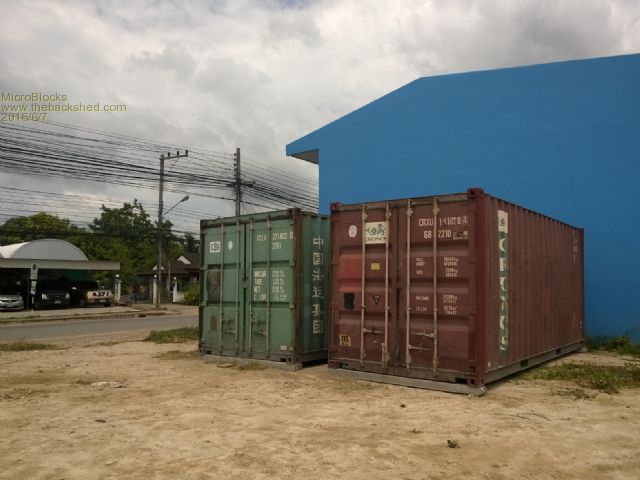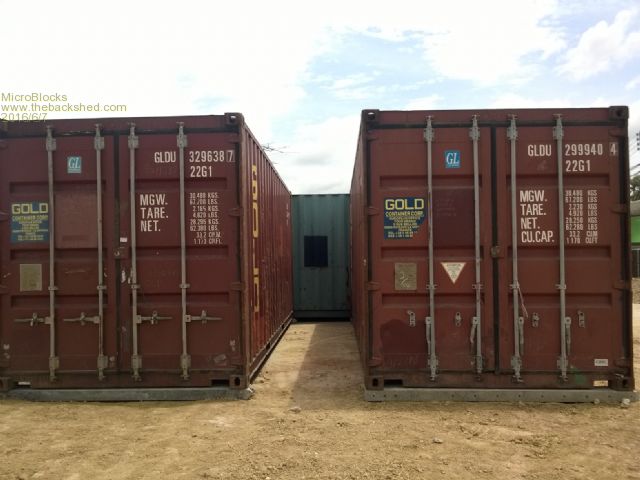| Author |
Message |
MicroBlocks

Guru

Joined: 12/05/2012
Location: ThailandPosts: 2209 |
| Posted: 11:24pm 05 Jun 2016 |
 Copy link to clipboard Copy link to clipboard |
 Print this post |
|
I am ready moving all my stuff from Bangkok to Prachuap. I will be using sea containers to build a new workshop.
I am starting with two 20ft containers and i already placed them on the right spot.
The first thing i need to do is to connect the electricity.
One of the requirements is that i will need to ground all my equipment.
What would be the best way to 'ground'. Could i use the sea container itself and ground the whole container by using a 2 meter long ground stake close to it?
Or would it better to isolate the ground from the steel structure?
I am a bit worried to create a ground loop when i wire up 2 or more containers. (The plan is to grow to at least 12 containers)
What about protecting against lightning?
And last but not least, if i want to add solar (and wind) what kind of preparations should i make so that i can add that in a later stage.
Microblocks. Build with logic. |
| |
isochronic
Guru

Joined: 21/01/2012
Location: AustraliaPosts: 689 |
| Posted: 09:23pm 06 Jun 2016 |
 Copy link to clipboard Copy link to clipboard |
 Print this post |
|
What is the Thailand power supply like, is it earthed /shared phase etc ?
Is the actual soil/foundation going to be conductive ?
The containers will always be a conductive shell obviously... don't
know how good a faraday cage they will be though. Lightning strikes
wherever it wants, I think !
Perhaps set up a small shrine, and sacrifice a few chips :) |
| |
MicroBlocks

Guru

Joined: 12/05/2012
Location: ThailandPosts: 2209 |
| Posted: 02:15am 07 Jun 2016 |
 Copy link to clipboard Copy link to clipboard |
 Print this post |
|
The soil is clay, sand and moist, so a stake should provide a good ground.
There is not really a foundation. The containers rest on a few concrete blocks on a concrete slab, and some of them have an old tire filled with concrete as a foot..
The connection to the mains is normally a 'Live' and a 'neutral'. The 'neutral' should be connected every certain distance to a ground but i did not see that in practice. Not many people use ground as most people are unaware of the dangers and if they have some protection it is in the form of a 'safety cut'. A device that measures the difference between live and neutral and breaks when there is a leak somewhere. They are pretty good and function here as a substitute for a real 'ground'.
I am having machines though that are metal and require a ground connection.
The laser cutter when touched gives a tingle when not connected to ground.
I am planning to use several containers and have the mains connected to all of them. My worry is that a container if part of the 'ground' would be a great attracter for lightning. I think, but i do not know, that it would be better to have the ground isolated from the container but then a short with the container could possibly make the container itself a hazard.
I simply do not know enough how to connect it, and unfortunately in Thailand a certified electrician knows not much more as i have seen their work and it is terrible.
So i have to educate myself and make sure it is done the right way.
Microblocks. Build with logic. |
| |
Madness

Guru

Joined: 08/10/2011
Location: AustraliaPosts: 2498 |
| Posted: 02:31am 07 Jun 2016 |
 Copy link to clipboard Copy link to clipboard |
 Print this post |
|
They are supposed to fit ground to any new installation as I understand it, at least around Chiang Mai.
Copper over steel earth stakes are readily available, have you got a Global House near you they keep all that stuff.
You should only have one and only one ground for your electrical earth, otherwise a nearby lightning strike will cause a massive difference in potential across the different earth's and that will cause big problems.
I have a shipping container set up with all my charge controllers, inverters etc in it. There is a separate earth stake for the house which is the electrical ground. Then the container is grounded separately but isolated from the electrical ground wiring.
BTW Thai electricity is safe you don't need earth Mai pen rai :)
There are only 10 types of people in the world: those who understand binary, and those who don't. |
| |
MicroBlocks

Guru

Joined: 12/05/2012
Location: ThailandPosts: 2209 |
| Posted: 02:45am 07 Jun 2016 |
 Copy link to clipboard Copy link to clipboard |
 Print this post |
|
Yeah, The 'Mai pen rai' attitude is the norm.
Here in Prachuap they are still a little behind i guess, not a single house in the area is connected to ground.
I have a copper over steel stake, about 2m long.
Here is the situation (2 containers for a workshop):

And about 15 meters from that (3 container in a 'u' shape):

Electricity will come from the pillars you can see in the picture. There are four wires so it is even possible to get a 3-phase connection, which might be useful when i am adding some power hungry machine like a vacuum former.
Once i have my basic knowledge gathered i can make a schematic of how i want to connect it.
Microblocks. Build with logic. |
| |
yahoo2

Guru

Joined: 05/04/2011
Location: AustraliaPosts: 1166 |
| Posted: 03:46am 07 Jun 2016 |
 Copy link to clipboard Copy link to clipboard |
 Print this post |
|
the way I do it is to earth the AC wiring back to a single point, usually in the junction box/meter box/ fuse box, then run a single wire to the ground stake.
your best bet for lightning protection is surge protection devices. they use good quality thermal metal oxide varistors rated for about 300 volts AC and protect both the active and neutral. if you have machines that are worth protecting then dont skimp on SPD's, more is better. They do wear out and can be rebuilt with fresh lollies.
If you are worried about a direct hit, lightning rods on two opposite corners of the building earthed to their own ground spike combined with the shrine will be 20% better than dumb luck. 
when you upgrade to the (grid connected?) solar system the panel frames and rack can act like a giant capacitor and build a charge, in theory they are supposed to be earthed to their own ground point. The solar wiring can build a voltage spike from nearby lightning, so a 600volt DC SPD is used for protection on the DC side of the inverter.
If you go off grid or run a generator there are a few other things to consider.
I'm confused, no wait... maybe I'm not... |
| |

